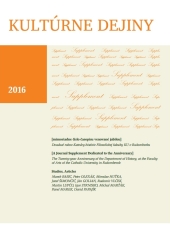Avanturista, nebo oběť? K životním osudům jednoho pravoslavného vladyky v období totalitních režimů
Adventurist or Victim? Concerning the Life Fortunes of One Squire in the Time of the Totalitarian Regime
Author(s): Pavel MarekSubject(s): History
Published by: VERBUM - vydavateľstvo Katolíckej univerzity v Ružomberku
Keywords: Orthodox Church; Czechoslovakia; bishop; Michal Kančuha
Summary/Abstract: The study intends to reconstruct the trip of a squire-vicar of the Orthodox eparchy of Michalovce, Metod (Kančuha), into the American Carpatho-Russian diocese, in the jurisdiction of Constantinople Patriachate, and to Johnstown, in Penssylvania, in the USA, in 1964, which, in fact, changed into an emigration. One year later, he came back to his home country, because of an amnesty by the president, but the totalitarian regime and the leadership of the Church precluded him, in consequence, from a return to his pastoral activities. The case is set within the broader contexts of the squire’s life story. The study has the character of a primal outline of the problematic, with the aim of summing up the known facts to date, detect any empty spaces and identify follow-up research for this topic, concerning the history of the Orthodox Church in Czechoslovakia, in the 20th century.Michal Kančuha came from north-eastern Slovakia, from an area abundantly populated by Ruthenians, which became one of the centres of the Orthodox Church within the Slovak Republic, in the 20th century. He was born in the village of Vyšný Orlík, near Svidník. His childhood and youth was influenced by the difficult social situation of a large family. Therefore, as a boy in the mid 1930’s, he found himself in an Orthodox monastery in Ladomirová, where he was trained as a typographer. He spent two years (1937 – 1939) in a monastery, in Počajev in Volyn, where he was educated and prepared for religious life. In 1942, he was enlisted into the Slovak Army to the Eastern Front. Here, in the south Ukrainian Melitopol, he became a monk, and from the hands of Bishop Seraphim (Kušeneruk), he received a priestly ordination. In 1944, after switching to a reserve, he retired as an Orthodox priest to Banská Bystrica. Here, in the summer, he joined the Slovak National Uprising and, after its suppression, in several partisan groups he fought against the German Nazis. At the turn of 1944/45, he was involved in the matter of the transfer of the Slovak Orthodox Church, under the jurisdiction of the Russian Orthodox Church. In this period, he belonged to a group of elites at the head of the Church. In the coming years, he lost his position, due to an inclement of influential people at the head of the exarchate and even the signing of the binding protocol of the STB did not prevent his fall. Up until 1953, he replaced priests in the religious communities of Košice, Čirč and Veľký Bukovec. In the years 1953 to 1957, after a disagreement with the leadership of the Orthodox Church, he studied at the Prague Academy of Russian Language and Literature. In 1958, he returned into the church and until 1962, he led a religious community in Strážske. Then he took the place of the bishop-vicar of the eparchy, based in Michalovce.The pastoral work of Bishop Metod (Kančuha) in the east of Slovakia, in 1964, interrupted his business trip to the Greek island of Rhodes. From there, he travelled to the USA to visit the US Carpatho Russian Orthodox eparchy located in Johnstown. The authorities of the totalitarian regime of Czechoslovakia perceived it as emigration, and although in the following year he returned to his homeland under the amnesty of the President of the Republic, he was deprived not only the possibility to return to his seat in Michalovce, but he also received a ban of pastoral work, with a recommendation to find a job outside the church. The efforts of Bishop Metod concerning rehabilitation in the years 1965 to 1981 were not successful. Neither the state nor the Church leadership offered him a helping hand, so his effect in the Orthodox Church in Czechoslovakia ended prematurely, at the age of 44. Bishop Method represents a controversial figure in the history of the Orthodox Church in Czechoslovakia, after WW2.
Journal: Kultúrne dejiny
- Issue Year: 7/2016
- Issue No: Supplem
- Page Range: 132-170
- Page Count: 39
- Language: Czech

